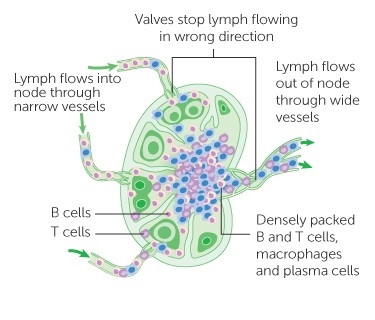
The network of lymph vessels carries the lymph fluid through tiny, bean-like glands called lymph nodes. As lymph flows through the spongy tissue of the node, cells called lymphocytes and macrophages identify germs and attack them. The lymph nodes also work like a filter to clean the lymph. The cleaned fluid then flows out of the node and continues to the bloodstream.
There are two kinds of lymphocytes — B-lymphocytes (or B-cells) and T-lymphocytes (or T-cells).
B-cells make antibodies that attach to germs and let your immune system know they need to be killed off.
T-cells have a couple of jobs. Some destroy germs, while others keep track of immune cells. They let your body know when to make more of certain kinds and less of others.
Lymph fluid also carries protein, waste, cellular debris (what’s left after a cell dies), bacteria, viruses, and excess fat that are filtered by the lymphatic system before it’s dumped back into the bloodstream.
Picture Credit : Google
